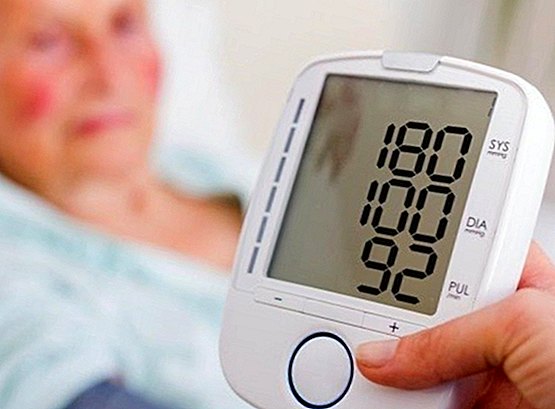What is blood pressure and how to measure it at home easily
To understand what is arterial hypertension, and especially what it means in terms of risks and consequences for our health, it is necessary to inquire about what exactly is the blood pressure, since in many occasions we tend to talk about high blood pressure levels without knowing what it means.
The truth is that the high blood pressure It becomes a fairly common disease, which affects millions of people around the world every day. In most cases it appears as a consequence of having followed unhealthy health habits for a long time.

While, at other times, it arises as a consequence of some specific disease, as occurs for example with common chronic conditions such as the case of diabetes.
What is the blood pressure?
It is also known as venous pressure Or simply blood pressure. In fact, all these denominations can be very helpful when it comes to discovering what it is, being useful to discover precisely what it is, without having to go to a specialized medical encyclopedia.
Basically, we could define blood pressure as the force that blood exerts against the different walls of the arteries. It is usually confused with blood pressure (TA), which consists, however, in the pressure that the different blood vessels exert on the circulating blood; that is, blood pressure, however, is the way our arteries react to the pressure exerted by the blood vessels.
This blood pressure is as fundamental as it is essential, because thanks to it blood can circulate through blood vessels, providing oxygen and nutrients to all organs and tissues of our body, so they can function properly.
In fact, blood pressure is determined by the volume and strength of the pumped blood, in addition to the flexibility and size of our arteries.
In the particular case of blood pressure it has two main components: on the one hand we find the one known as systolic blood pressure, which corresponds to the maximum value of blood pressure just when the heart contracts (systole), in the case of the pressure effect that blood exerts when it is ejected from the heart on the wall of blood vessels.

On the other hand we find the diastolic blood pressure, which corresponds to the minimum value of blood pressure, just when the heart relaxes after a contraction, in preparation for its filling with circulatory blood (between heart beats). It refers precisely to the pressure effect that blood exerts on the vessel wall.
In other words, while the upper number (systolic blood pressure) represents the maximum pressure that has been exerted when the heart contracts, the lower number (diastolic blood pressure) represents the pressure that exists in the arteries when our heart is in resting state.
Therefore when we measure blood pressure it tends to be expressed with two numbers separated by a hyphen: the first corresponds to the systolic pressure, while the second corresponds to the diastolic pressure. Incidentally, the one known as pulse pressure is the difference between systolic and diastolic pressure.
Did you know that blood pressure changes continuously? Not only does our state of health and our own physical state influence it.

Other factors such as the physical activity that we are carrying out at those moments (or that we have performed a few minutes before), the diet we follow, our emotional state, whether or not we are consuming certain medications, the temperature of our body ... and even the position that we have at the time of measurement.
Normal values of blood pressure:
- Normal blood pressure: 119/79 or less.
- High blood pressure (hypertension): 140/90 or more.
- Prehypertension: Between 120 and 139 for the highest number. Or between 80 to 89 for the lowest number.
Source: Medlineplus
how is the arterial pressure measured?
Blood pressure is always measured when we are sitting, with one arm resting on the table, which should be slightly bent so that it is at the same level as the heart.
In addition, it is important that the sleeves of the shirt are comfortably rolled, and that the upper arm is uncovered.
If the pressure is measured by a medical professional, the specialist will wrap the sphygmomanometer, tightly around the upper arm, approximately 2.5 centimeters above the elbow crease.

Then he will palpate the pulse to locate the major artery inside the elbow, now placing the head of the stethoscope on it, just below the sphygmomanometer. Now close the valve on the inflator rubber bulb, and then quickly compress it to inflate the sphygmomanometer until the meter reaches 30 mmHg above the normal systolic pressure (if this is not known, it inflates up to 210 mmHg).
Then the valve opens slightly, allowing the pressure to gradually decrease, registering the level in the meter while listening to the sound of the pulse of the blood (this is the systolic pressure).
As the air continues to come out the sounds disappear, so that when the sound has completely disappeared the exact point at which this happens (this is the diastolic pressure) is recorded.
And if you want to measure your blood pressure at home
If you want to measure your blood pressure at home, it is advisable to first consider the following basic tips:
- It is essential that you have a blood pressure monitor in your home.
- Take the measurement in the morning and at night, preferably on an empty stomach and before dinner.
- Try to always choose the arm that has the highest figures.
- Place the cuff two or three centimeters above the elbow.
- Try not to measure your tension when you feel nervous.
- Use a newspaper to measure the pressure.
- When you take the pressure, repeat two or three times, to verify that the data obtained in the first are correct.
- Sit in a place where you feel comfortable.
Once you have them in mind, if you have a digital blood pressure monitor, the truth is that the voltage can be measured easily.
To do this, you just have to follow the steps that we indicate below:
- Sit in a comfortable place.
- Put the cuff two or three centimeters above the elbow (remember, always use the same arm).
- Turn on the blood pressure monitor. It is important that you are calm so that the measure is as correct as possible.
- Stay relaxed while the blood pressure monitor takes your blood pressure.
- Ok, It's right.
If you wish, aim the measurement and repeat the process again, so you can be sure that the first value has been correct. This article is published for informational purposes only. It can not and should not replace the consultation with a Physician. We advise you to consult your Trusted Doctor.


